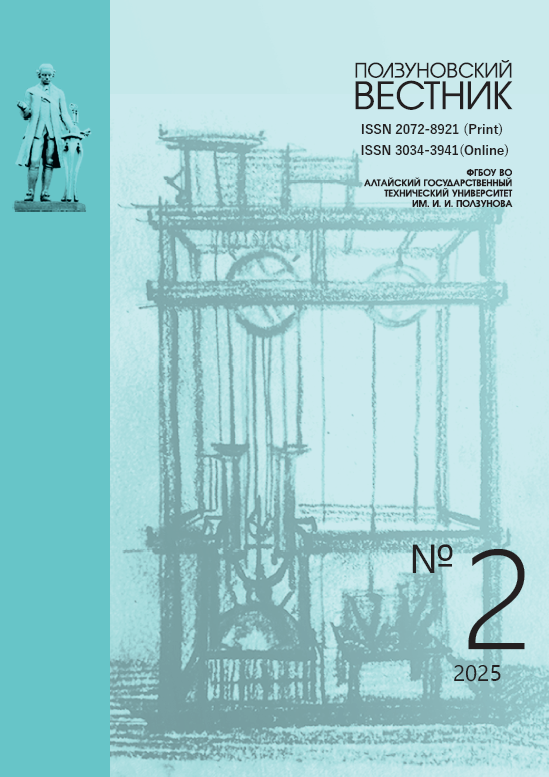EFFECT OF GRAIN PROCESSING METHOD ON DURABILITY OF SORGHUM FLOUR DURING STORAGE
IKWTZD
DOI:
https://doi.org/10.25712/ASTU.2072-8921.2025.02.019Abstract
The effect of the method of processing sorghum grain before grinding on the durability of sorghum flour during storage was assessed by assessing the acid number of fat, as well as its microbiological contamination. Four types of flour were studied, differing in the nature of grain processing before grinding: flour from sorghum grain that has undergone hydrothermal treatment (HTT) with vacuum humidification, resting and drying under optimal conditions, as well as hulling and polishing (V); flour from sorghum grain that has undergone HTT with steaming and drying under optimal conditions and the hulling and polishing operation (P); flour from sorghum grain that has not been subjected to HTT, but has undergone the hulling and polishing operation (WH) and whole grain flour from sorghum (WG). Flour samples were stored in thermostats at constant relative humidity (65.0 ±0.1%) at temperatures of 20.0 ±0.5°C and 40.0 ±1.0°C. The elevated temperature was used in the implementation of the "accelerated aging" method in order to intensify the microbiological and biochemical processes occurring in the flour. Flour was stored in two types of packaging: textile (cotton) bags and polymer (polyethylene) bags with a zip-lock. The determination of the acid number of fat, as well as the number of mesophilic aerobic and facultative anaerobic microorganisms (KMAFAnM) was carried out according to the current regulatory documentation. According to the research results, the shelf life of flour from sorghum grain that has not been subjected to HTT (WH), as well as flour from sorghum grain that has undergone HTT with humidification under vacuum V were determined. For flour from sorghum grain, due to the small change in acid number of fat, the storage life was set according to the calculated coefficient of conformity according to the "accelerated aging" method.
References
Шукис Е.Р. Потенциал возделывания сорговых культур в Алтайском крае / Е.Р. Шукис, А.Б. Володин, С.И. Капустин // Сельскохозяйственный журнал. 2018. С. 32–37.
Погода и климат // www. pogodaiklimat.ru. Электрон. текст. дан. Режим доступа: http://www.pogodaiklimat.ru/history/ 44277_3.htm. Загл. с экрана.
Горпиниченко С.И. Результаты селекции суданской травы / С.И. Горпиниченко, Г.М. Ермолина, П.И. Ляшов // Достижения, направления развития сельскохозяйственной науки России Всероссийский научно-исследовательский институт зерновых куль-тур им. И.Г. Калиненко ВНИИЗК – 75 лет. Ростов-на-Дону, 2005. С. 248–251.
Метлина Г.В. Агроэнергетическая эффектив-ность возделывания новых сортов и гибридов сорго сахарного / Г.В. Метлина, С.И. Горпиниченко, Н.А. Ковтунова, С.А. Васильченко // Политематический сетевой электронный научный журнал Кубанского государственного аграрного университета. № 114. 2015. С. 288–297.
Раева С.А. Производство зернового сорго в Ростов-ской области / С.А. Раева // Кукуруза и сорго. № 6. 2005. С. 12–14.
Ковтунов В.В. Основные направления ис-пользования сорго зернового / В.В. Ковтунов, С.И. Горпиниченко // Зерновое хозяйство России. 2011. № 6. С. 28–32.
Morya G.-C.K. Millets: The Indigenous Food Grains / G. C.K. Morya, H.S. Mishra, S. Shakya, B. Raj, K.N. Yadav // International Journal of Advanced Ayurve-da, Yoga, Unani, Siddha and Homeopathy. 2017. № 6(1). Р. 447–452.
Rathore T. Review on finger millet: Processing and va¬lue addition. / T. Rathore, R. Singh, D.B. Kamble, A. Upadhyay, S. Thangalakshmi // The Pharma Innova-tion Journal. 2019. № 8(4). Р. 283–291.
Шепель Н.А. Сорго – интенсивная культура / Н.А. Шепель. Симферополь : Таврия, 1989. 191 с.
Widowati S. Karakteristik Mutu Gizi Dan Diver-sifikasi Pangan Berbasis Sorgum (Sorghum vulgare) / S. Widowati // PANGAN. 2010. Vol. 19 (4). Р. 373–382.
Dykes L. Sorghum and millet phenols and an-tioxidants / L. Dykes, L.W. Rooney // Journal of Cereal Science. 2006. № 44. Р. 236–251.
Taylor J.R.N. Sorghum and millets: grainquality characteristics and management of quality requirements / J.R.N. Taylor, K.G. Duodu // Cereal Grains. 2017. P. 317–351.
FAOSTAT // Food and Agriculture Organization of the United Nations. Электрон. текст. дан. Режим доступа : https://www.fao.org/faostat/en/#data/QCL. Загл. с экрана.
Анисимова Л.В. Стойкость при хранении ячменной муки, полученной разными способами / Л.В. Анисимова, А.А. Выборнов // Известия высших учебных заведений. Пищевая технология. 2014. № 2–3. С. 41–44.
Солтан О.И.А. Разработка технологии овся-ной муки с интенсивным увлажнением зерна и мучных композитных смесей на её основе: дис. ... канд. тех. наук : 05.18.01 / Солтан Осама Исмаэил Ахмед. Барнаул, 2020. 196 с.
Выборнов А.А. Разработка технологии ячменной му-ки с использованием интенсивного увлажнения зерна: дис. ... канд. тех. наук : 05.18.01 / Выборнов Андрей Алексан-дрович. Барнаул, 2016. 145 с.
Downloads
Published
How to Cite
Issue
Section
License
Copyright (c) 2025 Ludmila V. Anisimova, Ekaterina S. Serebrenikova

This work is licensed under a Creative Commons Attribution 4.0 International License.















 .
. This work is licensed under a
This work is licensed under a 
